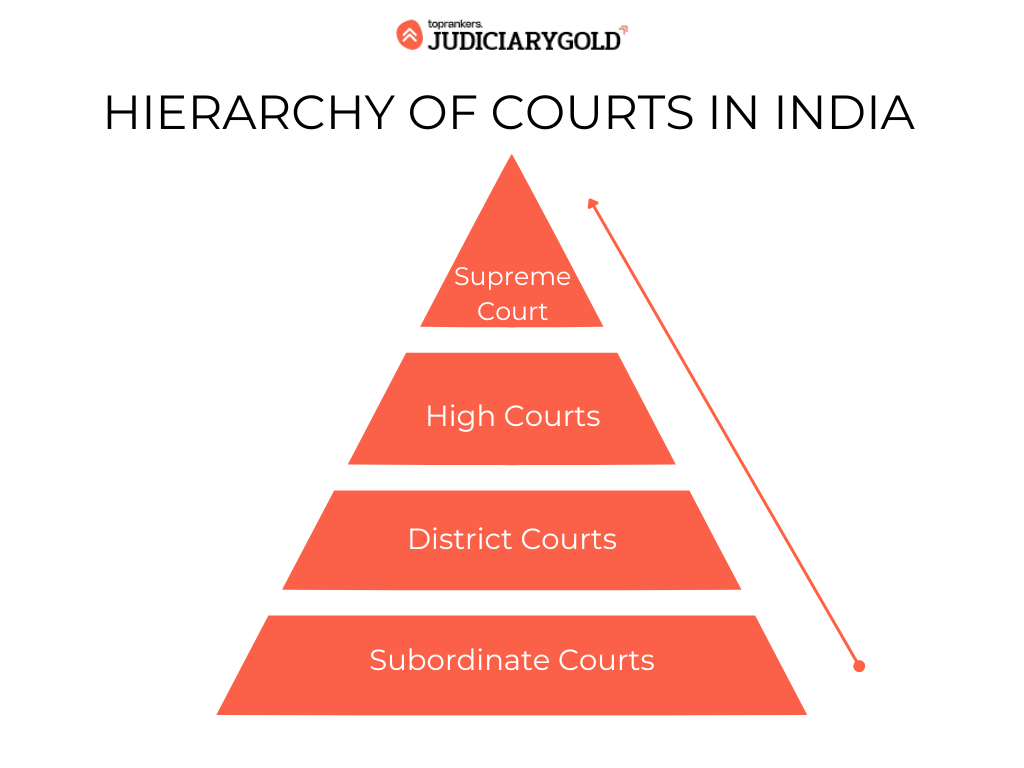India follows a well-defined hierarchical structure of courts that forms the backbone of its judicial system. The Indian judiciary structure is a unified and integrated system where higher courts control and supervise the functioning of the lower courts. This article explains the hierarchy of courts in India, their classification, functions, historical evolution, and roles.
Introduction to the Indian Judicial System
The judiciary in India is one of the three pillars of democracy, alongside the legislature and executive. It functions independently to uphold the Constitution and deliver justice. The structure of the judiciary in India is organized in a vertical hierarchy to ensure accessibility and uniformity in justice delivery.
Historical Background of the Indian Judiciary
The hierarchical structure of the Indian judiciary system has roots in the colonial era. The British introduced the Supreme Court in 1774 in Calcutta, which laid the foundation for today’s system. Post-independence, the Constitution of India established a three-tier system to preserve judicial independence and ensure checks and balances.
Types and Levels of Courts in India
Many ask, “How many types of courts are there in India?” The Indian court system is classified into various levels based on their jurisdiction and authority:
1. Supreme Court of India
The Supreme Court is the highest judicial authority in India. Established under Article 124 of the Constitution, it is located in New Delhi. It is the final court of appeal and has both original and appellate jurisdiction.
Key Functions:
- Safeguards the Constitution
- Hears appeals from High Courts
- Resolves disputes between states or between states and the Union
- Advises the President on legal matters
Historical Note: The Supreme Court was inaugurated on January 28, 1950, replacing the Federal Court of India.
2. High Courts
Each state (or a group of states/union territories) has a High Court that serves as the highest judicial authority within that jurisdiction. These are established under Article 214 of the Constitution.
Functions and Powers:
- Hear appeals from subordinate courts
- Issue writs under Article 226
- Supervise lower courts
- Handle civil and criminal cases
Some important High Courts include: Bombay High Court, Delhi High Court, Calcutta High Court and Madras High Court
Hierarchy of High Courts in India is below the Supreme Court but above district courts.
3. District and Subordinate Courts
District Courts function under High Courts and are established by the state government. They deal with both civil and criminal matters.
Types of Subordinate Courts:
- Civil Courts (e.g., District Judge Court, Civil Judge Court)
- Criminal Courts (e.g., Chief Judicial Magistrate Court)
- Family Courts
- Consumer Courts
Roles:
- First level of litigation for most citizens
- Base of the pyramid in the court hierarchy system
4. Specialized Courts
Apart from the traditional hierarchy, India also has specialized courts such as:
- Consumer Courts: Handle consumer grievances
- Family Courts: Focus on family disputes
- Labour Courts: Deal with employment-related issues
- Fast-Track Courts: For speedy trial in specific cases
Here with the help of flowchart, you can understand the hierarchy of court system in India clearly:

This hierarchy of courts in India and their jurisdiction helps maintain legal consistency and facilitates the appeal process.
Structure of Judiciary in India
The structure of judicial system in India is pyramidal. The Supreme Court sits at the top, followed by the High Courts in each state or union territory, then District and subordinate courts. This structure hierarchy of courts in India allows individuals to approach higher courts in case of dissatisfaction with lower court verdicts.
Hierarchy of Consumer Courts in India
The hierarchy of consumer courts in India is separate from the regular civil courts:
- District Consumer Disputes Redressal Forum
- State Consumer Disputes Redressal Commission
- National Consumer Disputes Redressal Commission (NCDRC)
Why is Court Hierarchy Important?
Wonder, “Why is the court hierarchy important?” Here are a few reasons:
- Uniformity in justice
- Appeal system for reviewing decisions
- Efficient administration
- Clarity of jurisdiction
These reasons explain why courts are arranged in a hierarchy and how they support legal order in the country.
Jurisdiction and Functions of Courts
The hierarchy of courts and their functions vary:
- Supreme Court: Constitutional interpretation, inter-state disputes, national appeals
- High Courts: Civil/criminal matters within states
- District/Subordinate Courts: Trials, evidence, local dispute resolution
Understanding the hierarchy of courts and their power helps in navigating legal options and appeals.
Conclusion
The hierarchy of courts in India forms an essential part of the structure of courts and ensures judicial efficiency, accountability, and uniform interpretation of Indian laws. The system is designed to provide justice to all citizens, from the grassroots to the highest level.
Useful Links
- Supreme Court of India Official Website
- Department of Justice, Government of India
- Wikipedia: Judiciary of India
FAQs
Q1. How many levels of courts are there in our country?
There are primarily four levels: Supreme Court, High Court, District Court, and Subordinate Courts.
Q2. What is the hierarchy of courts in India?
The hierarchy follows this order: Supreme Court > High Courts > District Courts > Subordinate Courts > Special Courts.
Q3. How many types of courts are there in India?
There are regular courts (civil/criminal) and specialized courts like consumer, family, labour, and environmental courts.
Q4. Why is there a hierarchy of courts in India?
To allow the appeal process, maintain consistency in judgments, and distribute legal authority efficiently.
Q5. What is the jurisdiction of various courts in India?
Each level has original or appellate jurisdiction based on case type and severity.



